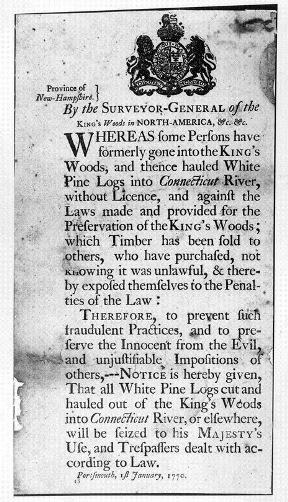…that cutting down a white pine tree was once a punishable offence.
The British Crown instituted the first White Pine Act in Massachusetts in 1691, but extended it to all of New England by 1711. The act prohibited the harvesting of white pine trees larger than 24 inches in diameter. Being relatively resistant to rot, soft and easy to carve, and reaching up to 250 feet tall and five feet in diameter, white pine trees became sought-after specimens for use as masts on Royal Navy ships.
The act (revised and reissued on multiple occasions) negatively impacted numerous businessmen in Connecticut, especially shipbuilders and sawmill operators. Foreshadowing colonial responses to the Stamp Act, Sugar Act, and numerous other regulations that (decades later) prompted the start of the American Revolution, reaction to the White Pine Acts incited organized protests as well as localized acts of resistance. In Middletown, for example, when Daniel Whitmore found Daniel Blake (a deputy surveyor of His Majesty’s Woods) searching his mill for illegal tree specimens in 1753, Whitmore promptly threw Blake into a millpond, nearly killing him. When Blake’s pleas for justice reached the Connecticut legislature, rather than punishing Whitmore, legislators eventually ordered Blake’s arrest on charges of trespassing.
In addition to resorting to acts of violence, resistance to the White Pine Acts also took more subtle forms. Those contracted with Great Britain to harvest the pines often smuggled some of their stock into the marketplace for profit, or cut down specimens in such a way that they knocked down extra trees as they fell. Thanks to wording within the acts that excluded trees found on lands divided among towns and on privately owned lands under development, colonists kept many of the trees for themselves by playing loosely with the definition of “under development.” Ultimately, the American Revolution brought an outright break between the colonies and Great Britain and placed the harvesting demands for white pines in the hands of the commercial market.









